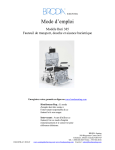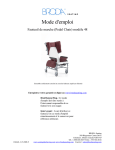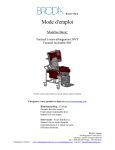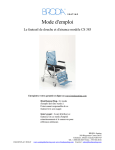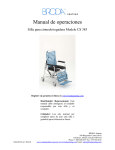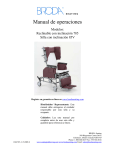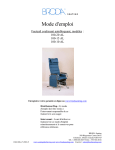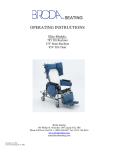Download SEATING OPERATING INSTRUCTIONS
Transcript
SEATING OPERATING INSTRUCTIONS Auto Locking Glider Models: 100-20 AL 100-15 AL 100-10 AL Broda Seating 385 Phillip St. Waterloo, ON Canada N2L 5R8 Phone Toll Free Can/US 1-(800) 668-0637 Fax: (519) 746-8616 www.brodaseating.com [email protected] December 16, 2004 Last Revised March 30, 2005 BRODA Auto Locking Glider Instructions for Use Foreword General Instructions 1 2 1.0 SAFETY INSTRUCTIONS 1.1 Before First Use 1.2 Application 1.3 Legal Restrictions 1.4 Position of Resident “Danger of Falling” 1.5 Position of Resident “Danger of Clamping” 1.6 Location of Chair “Danger of Tipping or Falling Objects” 1.9 Unintended Movement “Danger of Falling or Collision” 1.10 Resident Clothing “Risk of Injury to Resident’s Skin” 1.12 Improper Use 1.13 Cleaning 1.14 Preventative Maintenance 1.15 Resident Specific Instructions 3 3 3 3 4 4 4 4 4 5 5 5 6 2.0 DEFINITIONS and TECHNICAL INFORMATION 2.1 Definitions 2.2 Technical Information 2.3 Shipping and Storage Specifications 2.4 Labels 6 6 6 7 8 3.0 CAREGIVER MANAGEMENT 9 4.0 OPERATION and MOVEMENT 4.1 Auto Lock 4.2 Caregiver Lock 4.3 Height Adjustable Armrests 4.4 Transport Wheels 4.11 Broda Tray 10 10 10 11 11 12 5.0 INSPECTION and FUNCTIONAL TESTING 5.1 Inspection 5.2 Functional Testing 12 12 12 6.0 RESIDENT SPECIFIC INSTRUCTIONS (Additions to Section 1) 13 7.0 WARRANTY INFORMATION 14 BRODA Auto Locking Glider SEATING Foreword Congratulations on your purchase of a BRODA chair and thank you for your confidence in our company and our products. BRODA Seating has assumed a leadership position in providing the optimum in re-positioning functions and mobility for residents of long term care institutions. BRODA chairs do not look like traditional chairs and offer unique advantages found only with a BRODA. We are sure that after learning about BRODA, you will be convinced that your residents’ quality of life will be greatly enhanced by BRODA chairs. BRODA’s products were designed to be recommended by Professional Caregivers for residents who require long term care. The maximum benefit to the resident using this chair will be achieved with the advice and assistance of their Caregivers. This manual will assist you in making the best use of the functional capabilities of the BRODA chair and ensure that you will quickly become familiar with its use. If you have any questions about the safe and effective operation of your BRODA chair or accessories after reading this manual, immediately contact your local BRODA representative or our Head Office Customer Service personnel for further assistance. Head Office: BRODA Seating 395 Phillip St. Waterloo, Ontario, Canada N2L 5R8 Phone: Fax: (519) 746-8080 (519) 746-8616 Toll Free Can/US: 1-(800) 668-0637 E-Mail: [email protected] Website: www.brodaseating.com 1 BRODA Auto Locking Glider General Instructions The instructions contained herein provide guidance on the safe and correct operation of a BRODA chair. Safety measures as described in Section 1 must be observed when operating the chair’s functions or moving the chair. Only authorized caregivers should operate or move a chair. Every person that is involved with the operation and maintenance of the BRODA chair, including the resident’s family members, must read this instruction manual prior to moving or operating the functions of this chair. A copy of this instruction manual must always be available to these people. No person, including the resident’s family members, who is unfamiliar with or is unwilling or unable to adhere to the safety and operating instructions contained herein, should be permitted to operate or move the chair. A BRODA chair is designed for use within a Nursing Home, Hospital, or other Long Term Care facility where the potential users benefit from the assistance and care of professional caregivers. The safety and operating instructions that are included in this manual are very important to the safe and effective operation of the BRODA chair. The resident specific instructions in Section 6 (as determined by the resident’s professional caregiver responsible for their seating, from a part of the safety requirements detailed in Section 1) must be followed at all times. BRODA accepts no liability whatsoever for damage or disruption caused by operating errors, failure to provide proper maintenance, or the disregard of the instructions contained in this manual including the resident specific instructions. BRODA reserves the right to make changes to the specifications of the dimensions, functions, and components of its products. Any textual or diagrammatic representations provided are not necessarily exactly the same as the delivered products and are not required to obtain spare parts. Each BRODA chair is provided with a unique, identifying serial number. This serial number should be maintained on the chair and with your equipment records for future reference to obtain spare parts or additional copies of the operating instructions. 2 BRODA Auto Locking Glider 1.0 SAFETY REQUIREMENTS This section must be read by all operators of the BRODA chair before they attempt to use the product. It is the resident’s primary caregiver’s responsibility to ensure that only people who are familiar with the information contained in this manual are authorized to operate or move the chair. 1.1 Before First Use BRODA chairs are provided fully assembled and ready to use after purchaser inspection, functional testing, and training requirements have been met. If the chair does not appear to be in ready to use condition upon receipt, immediately contact your supplier and do not put the chair into service until after your concerns have been resolved. This manual must be read thoroughly by the caregiver(s) directly responsible for the resident’s nursing care before the chair is put into service. The chair must be visually inspected for damage, missing parts, and loose fittings (fasteners) prior to first use or testing the chair’s functions. Functional testing must be successfully completed after visual inspection and before first use. These obligations apply both to the first use of the chair and to all subsequent uses. (as described in Section 5, Inspection and Functional Testing) An in-service on the operation and safety issues, as described in this manual, must be given to the resident’s caregivers prior to its first use. (As described in Section 3.0, Caregiver Management) This manual must be read thoroughly by new caregivers, prior to the first time a new caregiver operates or moves the chair, after the chair has been put into service. A resident’s family members, who share some of the responsibility for a resident’s care, may be considered as a caregiver after they have read this manual, received instruction on the chair’s safe use by a professional caregiver, and a caregiver directly responsible for the resident’s care has given their approval. 1.2 Application BRODA chairs are intended exclusively for residents of long term care institutions who are under the care of professional caregivers. The Auto Locking Glider is intended for residents requiring mild to medium levels of care . The gliding motion helps to calm residents and reduce the need for wandering. The suitability and application of a BRODA chair is to be determined by a professional caregiver who is familiar with the seating needs of the resident using the chair. Any other use of the chair is excluded from possible liability claims. The Broda Auto Locking Glider is not to be used in the shower. Use in the shower may cause the frame or components to rust, and will void the warranty. The chairs are not explosion resistant and may only be used where there are no flammable gases or liquids present such as anesthetics or petroleum based cleaners. BRODA chairs are designed for use with specific BRODA accessories and spare parts. Any use of non-BRODA spare parts or accessories with a BRODA chair is excluded from possible liability claims. Any use of BRODA spare parts or accessories on a non-BRODA product is excluded from possible liability claims. 1.3 Legal Restrictions BRODA chairs may only be used as described in this manual and with proper regard for recognized health care and work place safety and accident prevention practices. BRODA chairs may not be operated or used with non-BRODA spare parts or accessories which could endanger residents, staff, or other third parties. The chair may only be moved or operated by caregivers or family members who can guarantee its correct operation because they have read and fully understood this manual and the safety issues discussed herein. 3 BRODA Auto Locking Glider 1.4 Positioning of Resident “Danger of Falling” We recommend that the resident be properly positioned in the chair with his/her feet correctly positioned on the floor to prevent sliding or falling forward off the chair. 1.5 Positioning of Resident “Danger of Clamping” It is important that the resident be positioned so that their arms are positioned inside the chair frame with their hands on their body and that the residents’ and caregivers’ body are clear of all pinch points. Failure to follow these safety measures can put the residents’ or caregivers’ limbs at risk of injury. Residents who may be unaware of their body position or unable to maintain a safe body position are at the most risk of the danger and caregivers should be more cautious with these residents. 1.6 Location of Chair “Danger of Tipping or Falling Objects” We recommend that when a resident has been moved to their destination, the chair is placed where the resident cannot reach handrails or other objects, fixed or moveable. This is to prevent the resident from pulling the chair over or pulling themselves off the seating surface and to prevent the resident from pulling moveable objects onto the chair and themselves. The Auto Locking Glider has two rear transport wheels to allow for easy transporting. Do not transport the chair while it is occupied. We recommend that the chair be used in a supervised area to prevent untrained residents, caregivers, or third parties from unauthorized operation, movement, or unsafe actions such as sitting or leaning on the back or the armrests. These actions, if not prevented, put the chair at risk of tipping or damage to the chair. We recommend that a chair only be located on a level surface to minimize the risk of tipping over. 1.7 Unintended Movement “Danger of Falling or Collision” We recommend BRODA chairs for indoor use within a long term care institution and where there is not enough slope to cause the chairs to move unaided. Chairs used where the surface is uneven or sloped are at risk of unintended movement and could become a serious danger to the resident, caregiver(s), or a third party. We recommend that BRODA chairs are located away from stairwells, elevators, and exterior doorways within a long term care institution. 1.8 Resident Clothing “Risk of Injury to Resident’s Skin” We recommend that residents only be seated while they are fully dressed in clothing that meets the needs of their specific condition. The Auto Locking Glider comes with a soft, abrasion-resistant vinyl padding on the seat and back. The seat and back consist of industrial grade vinyl strapping that reduces pressure and provides long term comfort. If after being fully dressed, a resident’s bare arms, legs, or body could still come into direct contact with the vinyl straps (if the vinyl padding is removed) or vinyl pads, the direct contact of bare skin on the straps over a period of time could cause moisture on the resident, and/or cause the skin to stick to the straps. Prior to the operation or movement of a chair with a covering, the caregiver must ensure any covering placed on the chair does not come into contact with any moving parts and is securely placed, so not to slip. 4 BRODA Auto Locking Glider 1.9 Improper Use The improper use of the chair can be dangerous to the resident, caregivers, or third parties through: 1) Unauthorized operation of the chair’s functions. 2) Unauthorized movement of the chair. 3) Inappropriate use of the chair for a resident who has not been assessed by the caregiver responsible for their seating. 4) Attempted simultaneous operation of multiple chair functions by one or more caregivers. 5) Attempted transporting of chair while occupied by a resident 6) Leaving the resident unattended in the chair near other objects. 7) Leaving a potentially agitated resident in an unsupervised area. 8) Leaving a resident unattended for a period of time 9) Leaving a resident in a chair on a sloping surface. 10) Leaving a chair unattended on a sloping surface. 11) Using non-BRODA accessories on the chair. 12) Using the BRODA chair at temperatures below 0 Celsius (32 Fahrenheit) 13) Using the BRODA chair as a shower or bathing chair. 14) Using the BRODA chair for any use other than its intended application 1.10 Cleaning We recommend the chair be wiped clean with soap and water. A dilute household strength ammonia or chlorine based cleaner may be used if necessary. BRODA chairs should not be cleaned with petroleum based cleaners. Any petroleum based products that come in contact with any vinyl surface should be removed as quickly as possible. Petroleum based products make vinyl brittle and will damage the seating surface and cushions. Metal parts and cushions should be wiped dry after cleaning. Solvents such as those found in spray lubricants should not be used on Broda Chairs as they can damage moving parts Touch up paint is available for the powder coated frame. Please call Broda’s Customer Service Department if touch up paint is required. 1.11 Preventative Maintenance The maintenance on a BRODA chair will vary with the amount of use and the condition of the resident using the chair. We recommend regular visual inspection for signs of wear, damage, loose or missing fittings, and other safety concerns. Also, periodic testing of the chairs functions is appropriate. If a breakage, defect, or operational problem is detected, the chair must be repaired, inspected and tested for function before it is returned to service. In regular use, after the initial inspection and functional testing, the chair should be inspected and tested on a bimonthly basis. The chair should be inspected and tested as often as each use if the chair is used: 1) 2) 3) 4) 5) By aggressive or agitated residents. By residents who have involuntary movement. On irregular or sloped surfaces. By residents weighing over 220 lbs By any unauthorized person. Do not use any lubricants that contain solvents. Solvents will damage many of the moving components in the chair. If necessary a white, food grade grease (lubricant) may be used on the sliding components in the chair. 5 BRODA Auto Locking Glider 1.12 Resident Specific Instructions The professional caregiver responsible for the resident’s seating shall add such additional instructions as are necessary for the safety and comfort of the resident using the chair based on their professional experience and knowledge of the resident’s specific conditions and requirements. These instructions form a part of the Safety Requirements for using the chair with that resident and must be made available to all caregivers. (see Section 6.0) 2.0 DEFINITIONS and TECHNICAL INFORMATION 2.1 Definitions “BRODA” means Broda Enterprises Inc. doing business as Broda Seating. BRODA “chair” refers to Auto Locking Glider Chair models 100-20 AL, 100-15 AL and 100-10 AL “Long Term Care Institution” refers to a Nursing Home, Hospital, or other Health Care facility that provides health and personal care to its residents on a long term basis. “Resident” refers to an individual living in a Long Term Care Institution under the care of Professional Caregivers. “Professional Caregiver” refers to the Doctors, Nurses, Therapists, Nurses Aids, Health Care Aids, and other Specialists who work in a Long Term Care Institution and provide health and personal care to its residents. “Caregiver” refers to any person in a Long Term Care Institution who is appropriately trained to provide care or services to the resident or the chair used by the resident and may include the resident’s family members or guardian. “Transfer(s)” refers to the movement of a resident into or out of a chair with the assistance of their caregiver(s). “Mechanical Transfer(s)” refers to the movement of a resident into or out of a chair with the assistance of their caregiver(s) using a patient lift or other assistive device that bears the weight of the resident. “Safety Requirements” are the important information contained in Section 1 which must be followed to ensure the safe operation of the chair for the resident, caregivers, and third parties. 2.2 Technical Information Overall dimensions of the Auto Locking Glider are approximately: 100-20 AL: 51” Height, 26” Width, 33” Length. 100-15 AL: 43” Height, 26” Width, 33” Length 100-10 AL: 41” Height, 23” Width, 33” Length All dimensions are plus/minus 0.5 inch. The seat width is 20 inches measured between the inside of the arms. The seat depth is 17 inches. The seat height is 18” inches measured to the front vinyl strap in the seat. The back length is 32 inches on the 100-20 AL and 26 inches on the 100-15 AL. The back width is 20 inches. Net chair weight of the 100-20 AL is approximately 65 pounds. Net weight of the 100-15 AL is approximately 61 lbs. Most dimensions can be significantly varied from the above descriptions by adjustments to the chair’s arms, vinyl straps or cushion positioning (see Section 4, Operation and Movement) Chair Frame The frame is all steel construction. The base, back, side panels and arms are powder-coated for durability and corrosion resistance. 6 BRODA Auto Locking Glider The auto locking function is supported by a mechanical locking device designed to permit gliding action when the chair is occupied, and to lock the gliding action when the chair becomes unoccupied. (See Section 4, Operation and Movement). No motors or other powered devices are used in the chair. Cushions Standard cushions include: Seat Pad, Back Pad and Side Pads. A Neckrest cushion is standard on the 100-20 AL (Tall Back Glider) The 27 ounce vinyl fabric covering is an ultrasoft leather feel with superior wear resistance and is manufactured to meet the following codes: BIFMA Class A, UFAC Class 1 and California Tech Bulletin 117 Section E. 2.3 Shipping and Storage Specifications BRODA chairs should be shipped and stored in an upright condition and not stacked higher than 3 boxes. No other materials should be shipped or stored on top of a BRODA box. BRODA boxes should not be placed on pallets. BRODA chairs should be shipped and stored at temperatures between minus 20 degrees Celsius and plus 40 degrees Celsius. BRODA chairs should not be used until they are between 0 degrees Celsius and 30 degrees Celsius. BRODA chairs should be kept in a clean, dry environment. Upon receipt, we recommend that the shipping carton be immediately examined for damage. Any damage should be noted on the delivery receipt and a request for inspection by the transportation company should be made. The shipping carton should be opened immediately and the chair examined for concealed shipping damage. If the chair appears to be damaged, a concealed damage report should be immediately filed with the transportation company. 7 BRODA Auto Locking Glider 2.4 Labels BRODA uses the following labels on the Auto Locking Glider: Manufacturers Label (White) Patent Label (White) PATENT PENDING MADE IN CANADA / FABRIQUE AU CANADA 385 Phillip St., Waterloo, ON. Canada, N2L 5R8 PHONE 1 – 519 746-8080 FAX 1-519-746-8616 Serial Number Label (Gray) SEATING 1-800-668-0637 PRODUCT # SERIAL # MADE IN CANADA 8 BRODA Auto Locking Glider 3.0 CAREGIVER MANAGEMENT BRODA Seating’s unique and innovative chairs provide the optimum in comfort and positioning. However, BRODA’s products were designed to be recommended by professional caregivers. The maximum benefit to the resident using this chair will be achieved with the advice and assistance of their caregivers. The professional caregiver responsible for the resident’s seating will add any additional resident specific instructions required for the safe and correct operation of the chair with a specific resident to Section 6.0 at the end of this manual. These additional resident specific instructions shall be considered as important additions to the Safety Requirements in Section 1 At the customer’s request, the initial basic training of the resident’s caregiver(s) in the operation of the chair will be provided by the local BRODA representative who supplies the chair. The caregiver(s) must adhere to the Safety Requirements at all times to ensure the safety of the resident, caregivers, and third parties. The customer will maintain a list of caregivers who have read this manual and are authorized by them to operate and move the chair. BRODA assumes no liability for damage, injury or accidents caused by careless, negligent, incorrect, or unauthorized operation or movement of its chairs. 9 BRODA Auto Locking Glider 4.0 OPERATION and MOVEMENT Safety measures as described in Section 1 must be observed when operating the chair’s functions or moving the chair. Only authorized caregivers should attempt to operate or move a chair. The caregiver must use proper body mechanics when operating the chair. 4.1 Auto Lock The Glider has an auto-locking mechanism that allows for resident safety: The mechanism causes the gliding motion to be either activated or locked, to help prevent residents from falling when getting in and/or out of the chair. - When the occupant sits in the chair, the gliding motion is activated (figure 1.0) - When the occupant begins to get out of the chair, the gliding motion is locked into place (figure 1.1) Figure 1.0 Figure 1.1 Tab in slot 4.2 Caregiver Lock The Glider has a caregiver lock that prevents any unwanted gliding. The lock is located at the rear of the chair. Note: It is recommended the caregiver lock be applied or released before the chair is occupied To Lock: - Locate lock handle on the rear of the chair near the seat - Turn handle approximately a quarter turn - Allow tab on handle to correspond with slot on lock (figure 1.2) -Allow tab on handle to insert into slot and release Note: Do not place fingers near slot Locked Position Figure 1.2 Tab To Unlock: - Pull out handle (toward the right) (figure 1.3) -Turn handle a quarter turn to move tab on handle away from slot -Release handle Figure 1.3 10 Slot Unlocked Position BRODA Auto Locking Glider 4.3 Height Adjustable Armrests The armrest height can easily be adjusted in order to accommodate various residents. The arms are adjustable in 5/8” increments and have a height range of approximately 5.5” The height increments allow for the arms to be easily leveled with one another to ensure proper arm positioning for users, and for accommodating dinner trays Figure 1.4 How to adjust armrest height - Lift up the flap on the outside of the side panel exposing the armrest height adjustment pins (figure 1.4) - Squeeze the 2 pins together. DO NOT place fingers at the top of the pins as this could cause pinching. Place fingers in the concave shape of the pins. (figure 1.5 ) Figure 1.5 - Raise or lower the arm to the desired height. DO NOT place fingers anywhere under the arm while adjusting, as this could cause pinching. Upon releasing the pins, the armrest will lock into place (figure 1.6 ) - Secure the outside flap on the side panel. Change the height on the other arm as desired 4.4 Figure 1.6 Transport Wheels The Auto Locking Glider has two transport wheels located at the rear of the chair to allow for easy transporting of the chair To transport chair: - Apply caregiver lock - Standing directly behind the chair, tilt the chair back onto the transport wheels (figure 1.7) - Transport the chair to the desired location - Return the chair to the upright position - Release the caregiver lock if desired Do not transport chair while it is occupied Note: Applying the caregiver lock while the Glider seat is in the most forward position may allow for easier transporting, as the chair does not need to be tilted back as far for transporting 11 Transport wheels (chair in upright position) Figure 1.7 BRODA Auto Locking Glider 4.5 BRODA Tray Grey Tray Clear Tray The optional BRODA tray is specially designed to work with your BRODA chair. The tray securely slides over the arms of the chair to provide a level surface of meals or activities. A BRODA strap may be used to prevent the resident from accidentally pushing the tray off the chair. The strap should be buckled together behind the chair back below the armrests and as close to the level of the chair seat as possible. A tray strap with a side buckle is also available to meet non-restraining policies The clear tray is excellent for residents who may be agitated, as it allows them to see their feet. Note: The BRODA tray is not to be used as a restraint 5.0 INSPECTION and FUNCTIONAL TESTING Safety measures as described in Section 1 must be observed when inspecting or testing a chair. Only authorized caregivers or maintenance staff should attempt to inspect or test a chair. 5.1 Inspection We recommend regular visual inspection for signs of wear, damage, loose or missing fittings, and other safety concerns. If a breakage, defect, or operational problem is detected, the chair must be repaired inspected and tested for function before it is returned to service. We recommend that the chair be inspected as often as each use if there is any reason to be concerned about the possibility of increased wear or loose or missing fittings. At a minimum, in regular use the chair should be inspected on a bimonthly basis. The visual inspection procedure should include at least the observation of each of the fittings (fasteners). The visual inspection procedure should include at least the observation of the following parts: 1) 2) 3) 4) The auto locking mechanism (Check for signs of wear on the auto locking plate) The cushions The caregiver lock and manual lock out plate The armrest height adjustment pins We recommend the visual inspection procedure should include the observation of any installed accessory such as the Broda Tray. 5.2 Functional Testing We recommend that the chair should be tested for operation of the chair’s functions without a resident in the chair. The testing may be as often as each use if there is any reason to be concerned about the possibility of increased wear or damage to the chair’s components. At a minimum, in regular use the chair should be tested for functions as described in Sections 4.1 to 4.9. If the caregiver or maintenance department performing the functional testing believes that any function is not operating correctly, the chair should be taken out of service until a satisfactory functional test can be completed. 12 BRODA Auto Locking Glider When performing repairs or maintenance, do not use lubricants that contain solvents. Solvents will damage many of the moving components in the chair. If necessary, a white, food grade grease (lubricant) may be used on the sliding components in the chair. . 6.0 RESIDENT SPECIFIC INSTRUCTIONS The suitability and application of a BRODA chair is to be determined by a professional caregiver who is familiar with the seating needs of the resident using the chair. BRODA and our representatives are not professional caregivers and will not know the specific requirements of the individual resident using the chair. BRODA relies on the knowledge, experience, and judgment of the resident’s professional caregiver to ensure the safety and comfort of the resident while using the chair. The primary caregiver responsible for the resident’s care and the caregiver responsible for the resident’s seating, shall add any specific instructions necessary for the safe and effective use of the chair. These instructions form an important part of the Safety Requirements for using the chair and must be made available to all caregivers. Space is provided her to include or attach these important instructions. _____________ Broda Enterprises Inc. 385 Phillip St. Waterloo, Ontario Canada N2L 5R8 Phone: 1-519-746-8080 Fax: 1-519-742-8616 Toll Free US/Can. 1-800-668-0637 www.brodaseating.com Email: [email protected] 13 BRODA Auto Locking Glider 7.0 BRODA SEATING WARRANTY BRODA provides a Three Year Warranty on the chair frame, and a One Year Warranty on all other components subject to the following conditions: No warranty is provided on seat pads or cloth covers. The chair frames are guaranteed for three years against structural defects or failure. All other parts (except seat pads and cloth covers) including but not limited to strapping, cushions, gas springs and attachments, casters, wheels, brakes and armrests are guaranteed for one year against defects in materials and workmanship based on normal institutional use. The guarantee does not cover malicious or deliberate damage or damage from misuse. The guarantee does not cover use of Broda chairs in a shower or pool, with the exception of the Broda Commode/Shower Chair. Modifications to Broda products or the use of non-Broda supplied parts voids the warranty. This warranty does not cover shipping damage (see below). BRODA will provide new or refurbished parts for installation by the owner at no cost following confirmation by the local BRODA Representative or the BRODA Head Office Customer Service Representative. On request, defective parts must be returned to the factory within thirty days of receipt of the replacement parts by the owner. If the defective parts are not returned to BRODA on request, the owner will bear the cost of the replacement parts on invoice from BRODA. Warranty does not include on-site labor for the installation of warranty parts or warranty repairs. The owner may return to BRODA products for warranty replacement or repair by shipping items prepaid and insured to the factory. Warranty completed at the factory includes both materials and labor. Parts to be repaired or replaced at the discretion of BRODA. All returns to the factory require prior authorization from BRODA. BRODA retains the right to make design and application changes without notice. All orders will be filled with BRODA's current models unless otherwise specified by the purchaser. BRODA chairs are designed for patient mobility, positioning, and comfort in specialty seating, however, the application of BRODA products shall remain the responsibility of the purchaser or user. This warranty is not transferable. RETURNS BRODA Seating will not accept any returns without a prior Returned Goods Authorization Number. Please contact our Head Office Customer Service Representative at 1-800-668-0637 for assistance. Returns must be insured when shipped. DAMAGED FREIGHT NOTIFY THE CARRIER OF ANY DAMAGE IMMEDIATELY It is the responsibility of the person receiving the goods to examine cartons and goods before accepting receipt. Note all damages on the bill of lading and file a claim if necessary. Notify the carrier of any concealed damaged within a maximum of 48 hours. BRODA insures all products for intransit damage, failure to notify the carrier of intransit damage voids both the insurance and the BRODA warranty. If you require assistance, please contact our Head Office at 1-800-668-0637. SALES TAX Most Broda products are G.S.T. Zero Rated and Exempt from Canadian Provincial Sales Tax. Purchasers may be required to check with their Provincial or State Tax Office for purchaser tax payment. _____________________________________________________________________________________________ 14
















